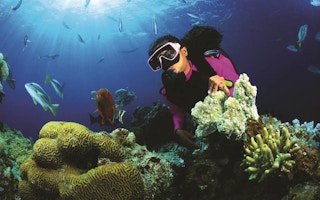Ashani Arulananthan says she can recall childhood visits to the beach in her home village in Sri Lanka’s northern district of Jaffna. She would collect washed-up pieces of coral, and her father would share his own memories of the dazzling beauty of coral reefs emerging during low tide.
This sparked her interest in corals and set her off on the path toward science. Today, Arulananthan is a researcher at the University of Peradeniya, and lead author of a 2021 study cataloguing the rich coral diversity of her native Jaffa Peninsula.
For decades, research in Jaffna, and indeed much of northern Sri Lanka, was virtually impossible because of security reasons: The region was under the control of the Tamil Tigers, or LTTE, the rebel group waging a civil war against the Sri Lankan government. With the defeat of the LTTE in 2009, the northern region slowly began to open up. Arulananthan and her colleagues carried out their coral survey from March 2017 to August 2018.
Their headline finding is the sheer wealth of coral biodiversity along the very northern tip of the Jaffna Peninsula and a handful of nearby islands in Palk Bay. They found 113 species of hard, or scleractinian, corals, 36 of which have never been recorded anywhere else in Sri Lanka.
Challenging research
Arulananthan tells Mongabay she knew it would be a difficult task to research the corals in Jaffna. Most corals in Jaffna form what are known as fringing reefs, which that grow seaward directly from the shore. But there are several islands that have corals around them that run as deep as 20 metres (66 feet), so it was essential to find capable divers to study them.
For this, Arulananthan turned to the National Aquatic Resources Research and Development Agency (NARA) and Ocean University of Sri Lanka for access to their expert divers. The divers took photos during the surveys at each site, which were then used to identify each coral species.
“
Most fishermen do not understand the value of corals which they consider only to be an obstacle for fishing as corals get entangled in fishing nets.
Ashani Arulananthan, researcher, University of Peradeniya
The researchers also gathered coral samples to carry out DNA analysis for species that were harder to identify. This posed its own challenges. The first set of samples proved failures as the DNA was contaminated. Arulananthan then had to find a way to preserve the samples until she could get them to a lab at the University of Peradeniya, about 320 kilometres (200 miles) away.
In the end, their efforts paid off. In addition to identifying the coral species, the survey also found a high level of average live coral cover along the Jaffna Peninsula, at 48.5 per cent; in the surrounding islands, there was an average of 27 per cent live coral cover. That means this region “has the highest live coral cover among the regions of Sri Lanka,” the study says.
And while corals in southern and northwestern Sri Lanka have suffered from severe bleaching events, those in the northern Jaffna Peninsula remain relatively untouched and maintain a rich diversity, says study co-author Anura Upasanta, a researcher at the Ocean University of Sri Lanka, who also dived to collect samples for the survey.
Climate-resilient corals
It’s not all good news for the corals in this region, however. Large stretches of reefs are being degraded by pollution or fishing activity, Arulananthan tells Mongabay. Because the corals found here are unusually resilient to climatic change and are likely to survive even harsher conditions, it’s important that they be protected and preserved, Arulananthan says.
The researchers also surveyed corals on four islands near the tip of the peninsula. These were found to be heavily degraded, with a high percentage of dead coral, the researchers say. They identified sewage discharge, destructive fishing practices, poorly managed resource exploitation, dredging, higher algal cover, and increasing sea surface temperatures as the main threats to coral survival.
“Most fishermen do not understand the value of corals which they consider only to be an obstacle for fishing as corals get entangled in fishing nets,” Arulananthan says.
To address this problem, Arulananthan held a series of awareness-raising discussions with Jaffna fishing communities, teaching them about the value of corals as the primary breeding ground for the fish they catch.
She also conducted lectures for school students in Jaffna to raise awareness about the value of corals as ecosystems. She says she found there was little or no understanding among the community about the key role that corals play as a natural buffer during high tides, and especially in reducing the impact of the 2004 Indian Ocean tsunami.
Study co-author Sivashanthini Kuganathan, head of the Department of Fisheries Science at the University of Jaffna, said the lack of funding for continued research is hampering further study.
Leading Sri Lankan coral expert Arjan Rajasuriya, a former research officer at NARA who was not involved in the study, welcomed the new findings as enriching the body of knowledge about Sri Lanka’s northern corals.
“Due to the long years of violent conflict, most of our work was not done in the northern waters,” says Rajasuriya, one of the few researchers who has consistently studied the Jaffna region corals.
Rajasuriya says the outcomes of studies like the recent one and his own should inform decision-making when it comes to coral conservation and management. But unfortunately, he says, in Sri Lanka this isn’t the case.
This story was published with permission from Mongabay.com.










